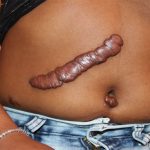 An overgrowth of fibrous tissue in a scar.
An overgrowth of fibrous tissue in a scar.
An excessive amount of scar tissue at the site of a skin injury.
Overgrowth of collagenous scar tissue at the site of a wound on the skin. The lesion is generally rounded and raised, often with clawlike margins; it may flatten and become less noticeable with time or it may be treated by cryosurgery, corticosteroid injections, surgery, or other means.
Elevated, firm hyperplasia with ill-defined borders; scar site.
A raised scar that extends beyond the original site of injury or that occurs around the incision line after surgery. Keloids are the result of an abnormal healing response and are caused by an excess buildup of collagen. Most keloids occur on the chest or on the earlobe after ear piercing. They may occur after an injury, surgical incision, or burn. Although harmless, keloids can be unsightly, and some are itchy or tender.
Hard prominent irregular scar tissue in the skin that often increases in size. It often forms where healing injuries, bums, or surgical incisions are under tension; for example, on the back or neck.
Hard lumpy nodule of the skin due to overgrowth of fibrous tissue in the dermis. It usually follows surgical or accidental trauma or burns, but, rarely, may complicate acne on the upper trunk. Most commonly seen in the skin over the sternum, shoulders and upper back. Injection of corticosteroid into the keloid may cause partial resolution.
An exuberant scar that forms at the site of an injury (or an incision) and spreads beyond the borders of the original lesion. The scar is made up of a swirling mass of collagen fibers and fibroblasts. Grossly it appears to have a shiny surface and a rubbery consistency. The most common locations for keloid formation are on the shoulders, chest, and back.
An elevated, firm, unevenly shaped scar that induces itchiness on the skin due to an aberrant healing process where an excessive amount of collagen (a robust, fibrous protein) is generated, often occurring subsequent to a skin injury. Keloids have the potential to emerge on any part of the body, although they are frequently observed on the breastbone and shoulder. This condition is more prevalent in individuals of Black descent than in those of White descent. Typically, over the course of a few months, most keloids flatten out and the itching subsides.
Injecting corticosteroid medications directly into the keloid can expedite the reduction of itchiness and induce partial shrinkage.
Excessive scar tissue development in a wound can lead to a raised, firm, growth-like appearance known as a keloid. Plastic surgery can address this issue. Even though there’s a chance of keloid reformation at the surgical site, the potential cosmetic improvement often justifies the risk. It’s also spelled “cheloid.”
A substantial elevated scar that extends beyond the dimensions of the initial injury.
